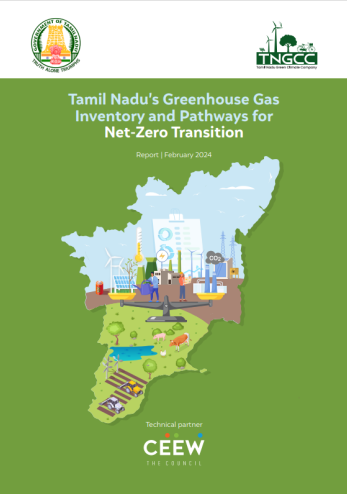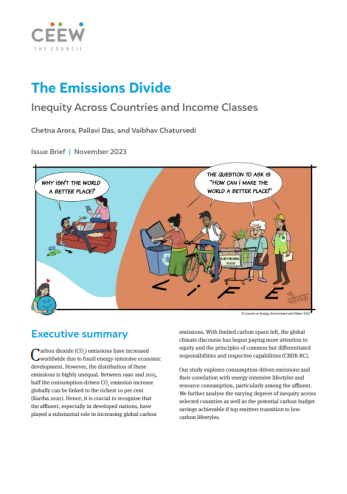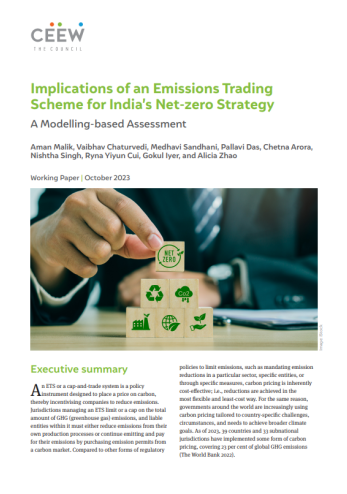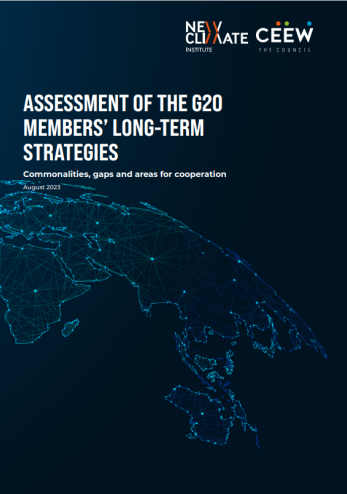



Suggested Citation: Singh, Nishtha, Vaibhav Chaturvedi, Chetna Arora, Alistair Ritchie, Josh Margolis, Trupti Mishra, Amit Garg, and Minal Pathak. 2023. Demystifying Carbon Emission Trading System through Simulation Workshops in India. New Delhi: Council on Energy, Environment and Water, Ahmedabad University, Indian Institute of Management - Ahmedabad, Asia Society Policy Institute.
CEEW's effort towards engaging relevant stakeholders in the preparatory phase prior to the establishment of the Indian Carbon Market (ICM) have shown that there is a limited understanding of an Emission Trading System (ETS) among Indian stakeholders and the importance of consistent engagement through capacity-building exercises. For capacity building of the stakeholders, CEEW in partnership with Asia Society Policy Institute (ASPI), Indian Institute of Technology, Bombay, Indian Institute of Management, Ahmedabad, Ahmedabad University and International Emissions Trading Association (IETA) organised three workshops in Delhi, Mumbai, and Ahmedabad in February 2023 for more than 200 participants. A question and answer (Q&A) session followed each workshop, which captured the relevant stakeholders' initial reactions, hopes, and concerns. This issue brief summarises the proceedings of the workshops and highlights the important questions raised by the stakeholders.
In our efforts towards engaging relevant stakeholders in the preparatory phase prior to the establishment of the Indian Carbon Market (ICM), we realised that there is a limited understanding of an Emission Trading System (ETS) among Indian stakeholders and the importance of consistent engagement through capacity-building exercises. For capacity building of the stakeholders, we organised three workshops in Delhi, Mumbai, and Ahmedabad in February 2023 for more than 200 participants. Each workshop was followed by a question and answer (Q&A) session, which captured the initial reactions, hopes, and concerns of the relevant stakeholders. This issue brief summarises the proceedings of the workshops and highlights the important questions raised by the stakeholders. The important questions and concerns that emerged from the discussions (as collated and presented in this brief) are as follows:
The Government of India has recently passed the Energy Conservation (Amendment) Bill, 2022, which envisages a provision to develop an Indian Carbon Market (ICM). After an initial voluntary carbon market phase, the ICM is expected to include a national emission trading system (ETS) for sectors and entities that are already part of the Perform, Achieve, and Trade (PAT) scheme, including power- and energy-intensive industry sectors. Obligated entities will be given a greenhouse gas (GHG) emission intensity target aligned to India’s overall targets and they can choose to abate and/or trade emissions allowances.
While Indian stakeholders have an experience in the offset market, there is still limited understanding of an ETS. Stakeholder engagements with Indian industry representatives conducted by the Council on Energy Environment and Water (CEEW) (Singh & Chaturvedi, 2023) reveal that educating the relevant stakeholders about the functional and operational aspects of an ETS is crucial.
In this context, CEEW, in partnership with the Asia Society Policy Institute (ASPI), International Emission Trading Association (IETA), Indian Institute of Technology, Bombay, Ahmedabad University, and Indian Institute of Management, Ahmedabad, conducted Emission Trading System (ETS) simulation workshops at Delhi, Mumbai and Ahmedabad for the benefit of the stakeholders. The 215 attendees of the workshop were from industry, financial institutions (domestic and international), academia, and civil society organisations.
The three workshops were limited-seating events, which provided a unique opportunity for its participants to learn how an ETS works through live in-person simulation sessions and associated training presentations and discussions. ETS simulation exercise remained the core focus of the workshop, but at the end of each session, we conducted a Q&A session to understand the perspectives and concerns of the stakeholders on the Indian Carbon Market.
ETS simulations help improve ETS literacy among the involved participants by providing a visual and interactive tool that allows the stakeholders better understand how the ETS works and its potential impacts. These tools can be used to build capacity of the stakeholders as they can test different scenarios and better prepare for the implementation of an ETS. Simulations can build support for the policy and reduce opposition from stakeholders by demonstrating the potential benefits of an ETS and addressing stakeholders’ concerns. They can facilitate the testing of design options by enabling policymakers to explore different scenarios and evaluate their potential impacts before ETS is implemented in real time. Simulations can reduce ETS roll-out time by helping stakeholders to become familiar with the system before its official launch.
A simulation exercise is different from the real carbon market in the following ways (World Bank, 2020):
While the terminology of ETS is used generally, we present a summary of the discussions in the context of the India Carbon Market (ICM) as most of the questions were related to how ICM would evolve and its various associated aspects. Within the ICM, we expect to have an ICM cap-and-trade (ICM-Compliance) market, which is essentially an ETS kind of system, and an offset market (ICM-voluntary) where the Government of India will approve projects and issue carbon credits through its own monitoring, reporting, and verification (MRV) system. This section discusses some interesting and important questions that were raised during discussions across the three simulation workshops.
A question that was echoed by many participants was related to the trajectory and level of carbon prices that the ICM-Compliance market could witness. It was clarified that the objective of the ETS simulation exercise was not to forecast prices in the ICM-Compliance market. However, there are some key aspects that would impact the long-term trajectory of carbon prices in the ICM-Compliance market. These are as follows:
All the points mentioned relate to the long-term price trajectory of carbon, but the short-term dynamics and fluctuations around the trend are impacted by many other factors.
This was one big question that was evident during the discussions across the three cities.
As the ICM market evolves, it is reasonable to expect that multiple types of players may participate in the market:
The roles, responsibilities, and privileges of each of these participants will generally be defined by specified ETS rules and/or the responsible regulatory entity and should be set in accord with considering the overall objectives of the ETS. For instance, California establishes holding limits, which serve to limit the number of allowances that participant players, liable entities, and financial players can hold. Policymakers can also impose restrictions that serve to limit market volatility, arbitrage opportunities, prices, and windfall gains that could otherwise be earned by participants. Moreover, given that the government is risk-averse, it may elect to come in and closely monitor the participation of financial players until such time as it decides that their broader engagement clearly contributes to the realization of underlying ETS goals.
One key concern that was highlighted was that financial players can influence the market in ways that could end up being detrimental to the Indian industry as the industry representatives are not experts in aspects like estimating/forecasting future carbon price trajectories. Regulating these players, therefore, would be essential in the long term. However, it should be understood that restricting financial players from the market can reduce liquidity, make it more difficult to manage market risk, and result in unnecessarily high prices. As such, regulators may seek a solution that tightly prescribes the roles, responsibilities, and prohibitions applicable to financial players who may wish to participate in the market.
As noted earlier, financial instruments can also play a significant role in the ICM. For instance, in particular, options (including puts and calls), futures contracts, and ‘carbon contracts for difference’ (CCfD) can be used to allow participants to secure the rights to allowances and offsets without having the need to secure title to such instruments on a spot basis. When appropriately included in carbon portfolios, such instruments can be used to hedge/manage risk, reduce volatility, moderate prices, and minimise calls on capital.
The decision on free allocation or auctioning needs to be guided by the stage at which ICM-Compliance market is and the carbon leakage risk of the covered entities. The knowledge about ICM-Compliance market will be very limited among market participants in the initial phases of the programme. The focus of this stage should be on capacity building with a motive of developing an understanding on basic mechanics of an ICM-Compliance market among the market players. Therefore, emission cap might be comparatively relaxed with free allowance allocation (either through grandfathering or benchmarking methods) provided to the participating entities. Such policy decisions of free allocation to companies will play a key role in shaping the ICM-Compliance market efficacy for India.
In the medium to long term, however, emissions caps should evolve to be much tighter. In place of intensity-based caps, India might also use absolute control caps. Additionally, the government could decide to limit the level of free allocation and gradually move towards an increased level of auctioning of allowances for sectors that can pass through their carbon costs.
Auctioning of allowances is a more transparent way of allowance allocation than free allocation. It strengthens the carbon price signal (embodying the polluter pays principle) and, as discussed in section 2.2, allowance auctioning can also generate revenue for the Indian government that can then be used towards providing valuable climate finance as well as towards supporting vulnerable communities and just transition.
Under the ETS, usually, there is a single emissions cap across sectors, while allocation of allowances or targets at the entity-level may be sector- or industry-specific. However, abatement costs are different across sectors as well as across entities within a sector. In the ICM-Compliance market as well, company-level abatement choices (including energy efficiency, fuel switching, and GHG emission reduction technology) would be based on their individual marginal abatement cost curves. For instance, two entities in the same sector facing similar caps might have different MAC curves wherein one might find abatement more cost-effective than trading in the market and vice versa. An ICM-Compliance market system by default will incentivise best-suited strategy at the firm level through clear signals.
If an entity faces a higher cost of mitigation in-house as compared to the price of emission allowances, it could decide not to implement an emission mitigation strategy in-house and instead would be a buyer of carbon allowances. On the other hand, if mitigating in-house is cheaper than the carbon price, the entity would decide to mitigate in-house and can generate significant revenue by selling allowances. An entity’s investment decision should ideally be based on the expected future carbon price that would apply to its investment, considering the time to implement the investment and its operating life, which is likely to be greater than the current market price. Entities have the option to delay implementing emission mitigation options in-house if they are very costly to do so and as emission reduction targets get tighter. Therefore, whether an entity decides to mitigate emissions sooner or later is a significant entity-level strategy that needs to be considered.
The ICM-Compliance market is expected to be based on emission intensity-based targets in the near future. Emission reduction targets are set based on GHG emissions (tonne of CO2e per tonne of the product). The absolute cap on an entity in this case will therefore be
Prescribed emission intensity (tCO2e/t of product) * total production (in tonnes)
This number also is rendered in tonnes of CO2e similar to an absolute emission cap.
While the mature ETSs have absolute emissions caps, there are good reasons for the same pattern not being followed in the ICM-Compliance market in its initial phase. The choice of absolute versus intensity-based cap has to depend on the context of a country. Emissions are heavily determined by the growth in GDP as shown in Chaturvedi (2021). For a fast-growing developing economy like India, it is very challenging to set absolute emissions cap due to uncertainties related to future economic growth forecasts. Once the GDP growth rate starts tapering with increasing per capita income, ICM-Compliance market can start shifting towards an absolute emissions cap, with adequate flexibility potentially including market stability measures and adjustments in allocations in line with actual production. Even jurisdictions that employ an absolute emissions cap can provide flexibility in terms of variability in emissions induced by an increase or decrease in production volume. For example, in EU ETS, if an entity’s production increases or decreases by 15 per cent of what was forecasted at the time of setting the emission cap, the allocation level can be adjusted.
As noted earlier, allowing liable entities to meet their compliance obligations by surrendering either offsets or allowances can provide increased flexibility and cost relief while also encouraging reductions from sources that are outside of the cap. To help achieve underlying ETS objectives, it is possible to narrowly prescribe the methodologies that can be used to create offsets, the geographic areas (both Indian and international) from which they can be secured, measures that must be used to minimise leakage, and the relative proportion that can be used to satisfy compliance obligations.
The Indian offset market will comprise the compliance offset market and the voluntary offset market. The compliance offset market will consist of offset market under the government-led ICM (ICM-voluntary) and the UN-driven market under Article 6 of the Paris Agreement. The ICM-voluntary market, in alignment with the ICM-Compliance market, will be used by policymakers to help India achieve its NDC. Under Article 6.2, two jurisdictions can come together under an agreement and bilaterally decide the nature of transactions between them with the aim of cost-efficient emission reduction. The Indian government recently published a list of 13 sectors that can generate credits and be transacted under Article 6.2. Similarly, offset trading can also happen under Article 6.4 and the rules for this trading are being finalised.
The voluntary offset market, on the other hand, is driven entirely by private players including project developers, accreditors, verifiers, and corporations seeking to meet their voluntary targets and local communities. The voluntary offset market should work independently of the compliance market.
The share of offsets (from ICM-voluntary market or Article 6) that will be allowed for surrendering against compliance targets under the ICM will entirely be a policy choice. However, offsets are expected to play an important role in accelerating the pace towards net-zero targets at the country level. Therefore, the government’s decision on the potential quota of offset usage in ICM-Compliance market will be crucial for market players.
Credits from the ICM-voluntary market will essentially increase the supply of credits in the ICM-Compliance market. How big or small this supply is in absolute sense, and to what extent will it impact the dynamics of carbon price within the ICM-Compliance market, will be determined by the magnitude of offsets allowed in the ICM. A decision to import up to 5 per cent of ICM-voluntary market credits in the ICM-Compliance market would have a much lesser impact on carbon price within the ICM-Compliance market as compared to a higher value of 20 per cent.
To protect their industrial competitiveness against rising carbon prices, the EU has announced the Carbon Border Adjustment Mechanism (CBAM), and similar mechanisms are also being considered by other jurisdictions including the United States. Under CBAM, the EU will levy carbon prices on the import of goods and commodities covered by the EU ETS, so that both EU-produced and -imported goods would effectively be covered by the same carbon price. EU views CBAM as a decarbonisation mechanism. However, an absolute carbon price on every country’s export defies the principle of Common but Differentiated Responsibilities (CBDR). Under CBDR, technology and finance should flow from the Global North to the Global South, but CBAM will result in capital flow from the Global South to the Global North. This arena is still evolving to assess its impacts. However, it is clear that the ICM-Compliance market will play a role in reducing the cost impacts of the EU’s CBAM for Indian exporting companies by imposing carbon costs on covered entities, as well as enabling cost-effective compliance with India’s 2030 NDC and longer-term net zero targets.
Like in the PAT scheme, there is a pre-determined threshold for entities to be able to participate in an ICM-Compliance market. These are usually large installations with significant levels of emissions. Therefore, in all likelihood, MSMEs will not be a part of an ICM-Compliance market and therefore there should be only a minimal direct impact on these entities. The indirect impact, however, needs to be better understood, especially for MSMEs that are a part of the supply chain of sectors that are going to be covered under the ICM-Compliance market.
It will be essential for policymakers to ensure the efficiency and reliability of the market structure. Consequently, strategic choices concerning emission caps, allocation regime, and MRV systems will be crucial for government stakeholders. MRV for ICM-Compliance market can be built upon the monitoring systems operational under the PAT scheme wherein energy-related information (e.g., fuel mix) is already recorded. Policymakers will also have to provide clear market signals in order for entities to devise long-term decarbonisation strategies.
Indian policymakers also need to ensure efficient preconditions in order to give out a best-suited ICM-Compliance market design aligned with the economy’s overall objectives. Cross-country learnings will play a key role, especially while deciding cap stringency, allocation method, role and scope of operation for financial players, and providing a transparent platform for trading of allowances, including over-the-counter (OTC) trades with a motive of minimising inefficiencies. However, replicating the exact ETS parameters as being done across jurisdictions like the EU, California, or Korea might not be the best option for India. India’s strategy should balance cross-country learnings, the economy-wide cost-effectiveness objective, and socioeconomic trade-offs. Additionally, liquidity under the ICM-Compliance market will depend on the level of cap in place as it will impact the long/short position of companies, which in turn will determine their demand for credits. A more stringent cap and policy certainty will also influence entities investing in entity-level in-house emission mitigation measures through technological innovations. This will mean that eventually entities may move from being allowance buyers to allowance sellers in the long term, thus impacting both the supply and demand sides. Therefore, through policy design, supply, and demand for credits and therefore liquidity in the market can be moderated by placing a stringent cap, providing policy certainty, and including sectors not covered under the PAT scheme at present in India.
Emission Trading system (ETS) is a quantity-based carbon market instrument where a regulator outlines the maximum level of GHG emission (cap) for a specified group of sectors/entities. The cap is then divided into a distinct number of emission allowances/credits and distributed over the entities to be regulated under the ETS. The entities that outperform their targets can trade allowances with the underperformers. The regulated entities need to submit one allowance/credit for each tonne of CO2e emitted during the compliance period.
Emission trading is a market- based approach of limiting emissions to a specified level. An ETS helps in entity-level decarbonisation, incentivise R&D investment in low carbon technologies, and achieve an economy level decarbonisation target in the most cost efficient way. An ETS can also generate revenue, which can be used to finance climate mitigation and adaptation measures.
The Government of India has passed an amendment to the Energy Conservation Act, 2001, which leads to establishment of a carbon credit market in India. The Indian Carbon Market (ICM) will include an ETS or a cap and trade market as well as an offset market. The cap and trade market under the ICM is tentatively scheduled to fully start working by 2026.

Tamil Nadu’s Greenhouse Gas Inventory and Pathways for Net-Zero Transition

The Emissions Divide: Inequity Across Countries and Income Classes

Implications of an Emissions Trading Scheme for India’s Net-zero Strategy

Assessment of the G20 Members’ Long-Term Strategies